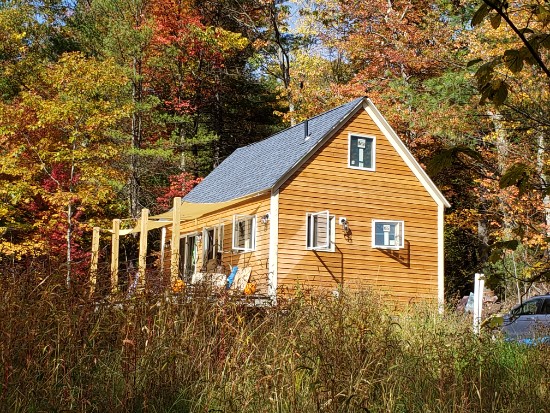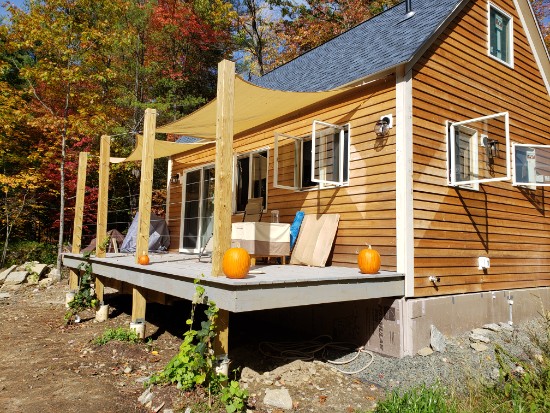Tiny House Interview

In July, New Escapologist contributor Paula Billups and her partner Scott moved into their brand-new tiny home in Western Massachusetts. They built it themselves with some help from friends. It has 384 square feet of living space with a basement and storage loft. Congrats, guys!
After watching loads of Tiny House videos online–which are usually success stories and often quite miraculous feats of resourcefulness–I wanted to hear about the challenges and expenses that I suspect would be encountered if you just wanted to build a Tiny Home right where you are. I mean, before even getting started, the land anywhere near where I live would cost so much money you’d be better off buying an apartment or continuing to rent one.
I asked Paula and Scott to be candid, not only about cost but about some of the Tiny House practicalities I’ve been curious about for a while. The interview happened in October. Hence the pumpkins you can see in that exterior photograph.
Paula says:
We belatedly realized that every article we read on the subject was by someone in rural Oregon, rural Montana, Arizona, places where building regulations are lax and few. Try doing that in Massachusetts sometime.
Over the course of the build the requirements, permits, and bureaucratic hoop-jumps grew daily. Our original plan was for an $18k yurt, but you can’t have a yurt as a primary residence in Massachusetts. And the permitting and code for building primary residences here is stringent. We ended up building a more permanent dwelling. Once land, a well and septic system were accounted for, we spent about £150k.
We bit off way more than we could chew.
There is a dark side of tiny-house building, which is to say that some people in some areas can build a home for under $20k and more power to them. But there are plenty of places where local government makes that an impossibility. You don’t hear much about that amongst the Tiny House crowd. It can be done. It is worth it. But there is a splash of cold water for those who find themselves in such a situation.

Did you consider any of the other popular ways of setting up a tiny home (e.g, shipping container or pre-fab) before settling on your final plan?
Scott: Our original plan was to build a 1,200sqft Post-and-Beam strawbale house. Financial and time constraints meant that we could not afford the architectural fees for a code-compliant strawbale house, nor the extra time necessary to build the house with the extra natural building labor costs. We decided to build a tiny house because it was cost-efficient, and was at a scale we could accomplish in less than a year.
We considered shipping containers, but my research said that it would be hard to properly insulate such a home to stand up to a New England winter. While I know the frame of the building would be far stronger than needed, proving the strength to a non-traditional home to an inspector was a challenge we didn’t care to take-on.
We looked briefly at Pre-fab homes. None looked like the aesthetics we were hoping to achieve, also the standard building materials were going to be a problem with my wife’s severe asthma. Finally, the costs were higher than the assemble-it-yourself we got with ShelterKit.
Paula: Yes, ShelterKit, take pains to create designs to customer specifications and budget while also being code-compliant. We couldn’t find another small-structure manufacturer who would do that. They were a real pleasure to work with. They were able to design a shell that would cost $27k, about $5k more than the cheapest-available yurt. Of course, that did not include anything to finish it out: just the shell, deck, roof system, doors, windows and hardware.
The local authorities would not give permission to what they see as temporary structures, nixing THOW (Tiny House on Wheels) and yurt ideas, nor would they allow us to inhabit the property without a well and septic system installed. That immediately more than tripled our cost. It also took nine months longer than we planned to get it all done.

What was your primary initial motivation to do this rather than just buying/renting a regular home?
P: Scott originally wanted land of our own to run some experiments with sustainable living and carbon-neutral strategies. Owning land is really the only way to do this without too many hassles.
As well, the Boston area’s cost of living continues to climb. Heading into our 50s, we wanted to think about a place that is functional, beautiful, livable, and permanent so we can plan a retirement budget with some stability and with beauty. We are roughly two hours west into Franklin County, which has beautiful forestes and mountains.
S: And we didn’t want to rent anymore. We’ve been doing that for many years, and we were ready to build-up some equity. Most standard homes would not be as energy-efficient as we wanted, and all were far too large and expensive for us. In New England, $500k would buy us 2,000sqft of home, that costs $300 per month to heat and cool on a half-acre of land.
A tiny house offered us the size we needed, really good energy efficiency, direct control over the materials used in the structure, and build-it-yourself offered us a reasonable cost.

What is the best thing about living in your beautiful, self-built home?
S: We get to live in a forest! We go to sleep to the sounds of frogs singing, and wake-up to the sounds of birds.
Heating and cooling are really inexpensive, even using all-electric appliances. Opening a few windows ventilates the whole house, making everything feel fresh and awake.
We could afford high-quality paint, tile, lights, everything, because we could afford small qualities of premium stuff. The place looks really spiffy. A thousand shout-outs to my wife, Paula for designing the aesthetics of the house. The overall footprint of house, the location of windows, the tile selection, paint colors, everything was done by her with great care and thorough consideration. I contributed considerations for passive solar heating, future solar panels, code compliance. I’m mostly responsible for making the house sturdy and efficient but she is responsible for how it looks and feels to live inside.
P: It IS beautiful, and there’s not a thing in it I don’t enjoy looking at. I spent ages thinking about and planning every angle, colour and fixture, and it is exactly the way I want it. Applying my art training to its fullest has made it a really lovely place to be.
It is incredibly peaceful and quiet, which is a wonderful escape from our noisy suburb of the last six years. We are sleeping SO well! We live in a “dark town,” meaning by law there is not a single streetlight in the town, and the natural darkness of night makes stargazing a breathtaking experience. Scott just turned 50 and our adorable friends all pitched in and got him a nice telescope, and we are learning to use it.
With my asthma, it also saves me a lot of breath to have a house where everything is only a few steps away.
For all the benefits, is there anything you miss or lack?
S: Not strongly, at least not yet. My biggest complaint is that there are several examples of “If you want to reach something, you have to move something else first”. Also, the location of chairs and small table in the living room seems to be unsettled. We are constantly moving them into a new configuration. That’s about the sharpest irk I have so far.
P: I have a small closet for storing art materials. This folds out into a very tiny work space, but I miss having a large dedicated studio space. We have a plan for that later on, but for now I have to improvise.
Not having good internet is a bit inconvenient, but we should be getting fiber installed in the next few months. Getting postal delivery sorted out has proven a challenge. Otherwise, we have all we need and nothing we don’t.

Random question. What about mail? Do you have to register a new property with the post office or something?
P: Mail has been a sore point. The property is new, and the red tape seems both unbreakable and opaque. So far we have an address, but the postal carrier can’t or won’t deliver to our box until the mileage on the delivery vehicle has been approved by the US Postal Service. The postal workers agree it should have been cleared up by now, but here we are.
How about community? Do you have one?
P: Tiny House owners are thin on the ground in Massachusetts. Mass. is not that hospitable even to individual builders on a budget, let alone tiny-house builders, so a lot of people go elsewhere — often Vermont or New Hampshire or out west to make it happen. So we don’t yet have a community around us, but it’s early yet. We do have an amazing, loving group of friends whose blood, sweat and tears went into the project. Most of them are in the Boston area.
S: We have moved two hours from our previous circle of friends. We can still reach them, but it’s more of an effort now. There are other long-time friends in our new town, but we haven’t yet had time to build a new friends circle with them. In the neighborhood grocery stores, there are community bulletin boards, and those are LOADED with local events and gatherings. The small-town community around us appears to be very active. Since we moved to the new area, we haven’t yet done much outreach to connect to the local community, but we plan to.

Do you have any plans for expansion? Outbuildings maybe, or agricultural projects?
P: Ohhh yes. A tool shed, parking shed, well house, food forest, straw bale experiments, are all things we have talked about, as well as trails and tree houses. This is a long-term project, and we have five acres of land to play with.
S: We need to pay down some construction loans for the next few years. After that, we might build the 1,200sqft strawbale home we dreamed about before we started all of this. That’s a few years off, so who knows what our goals will be then?
In the shorter term, I want to convert about three acres of our natural forest to a food forest. I am an engineer by profession, and the Permaculture approach to growing systems appeals to my mindset.
*
Paula Billups is a professional artist whose writing has also appeared in New Escapologist (Issue Twelve). Scott Billups is an engineer.




Robert: Well written artice. Do not appreciate calling them partners. They are married and have been for some time.
Sorry, but as a queer-friendly publication, we say “partner.”
Wonderful! Congrats guys! It’s really unfortunate that there are so many governmental limitations that force home ownership toward costly debt. But I’m proud of both of them for their huge (tiny) accomplishment.
I would be very interested in speaking with Scott and Paula about planning a tiny home in Western Mass. I also live in Franklin County and have a similar dream of going tiny in the near future.
Hi Greg. I’ve forwarded your message to Paula. She and Scott may well contact you (though the choice is theirs of course). Thanks for reaching out, and good luck with your project!